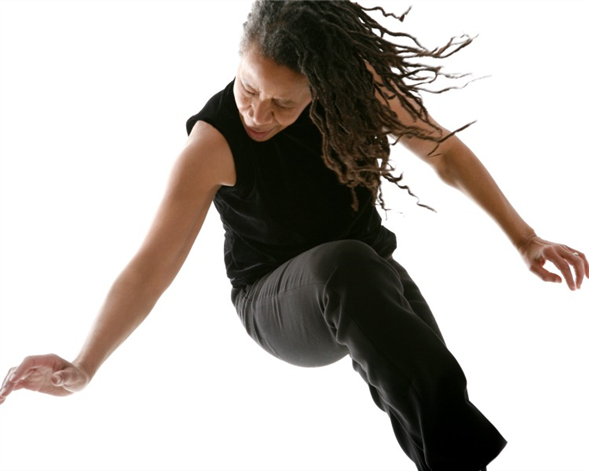Translate Page

Choreographer Bebe Miller explores the creative process in The Making Room
---
Choreographer Bebe Miller always prioritizes the investigative process. Even in the throes of creating, she likes to zoom out to consider how she actually makes the art. Does she prepare material before rehearsals? How does she engage the dancers in helpful dialogue? If the dancers are improvising, how does she decide which sections to keep, and how to order them?
These questions always remain front of mind for Miller as an artist and a person. In 2012, her full-company piece, A History, explored the creative process of working with her main collaborators: dancers Angie Hauser and Darrell Jones, and dramaturg Talvin Wilks. While that satisfied some of her curiosity, she wondered how adding another choreographer might enhance her understanding of dance-making.
So in 2016, she embarked on The Making Room to engage in "parallel play" with modern dance innovator Susan Rethorst. The two had performed together in 1977, but then gone off in their own directions. While Miller's swelling movements integrate energetic zeal with an abstraction of narrative, Rethorst's work feels direct and clean, with an underlying inquisitiveness about shapes and steps. Both are interested in the concepts of aesthetics and structure, but come at them from disparate vantage points.
That's why Miller saw a perfect ally in Rethorst, an equally respected but wholly different choreographer. "The idea was we'd convene three times over a year plus, as well as document the process and talk a ton," explains Miller. "It's not that we collaborated on a piece. Instead, it's watching and learning how another artist creates. How do we work? How is it different? How do those differences actually happen?"
From February 21 to 24, audiences can see the results of their Making Room project -- Miller's In a Rhythm and Rethorst's Stealing From Myself -- at New York Live Arts.
Miller says seeing her creative mechanics through the lens of a trusted colleague gave her the perspective she craved. Rethorst's input was especially useful considering Miller's choice of complex, cross-genre subject matter. "I had been reading works by David Foster Wallace and Toni Morrison, and I was struck by the particular shape of their language, the content of their pieces, their syntax," Miller says. To her, syntax is more than just the grammatical structure of a sentence or a phrase of movement. "It's how each artist creates a complexity of delivery, a specific rhythm. That's what we do in dance -- it's energy delivered through time. I was hoping to use this piece as a way to sit with the idea of syntax in that poetic fashion. The audience can follow me in looking at how the movement, rhythm, and structure I chose shapes the timing and delivery they receive."
While the idea is cerebral, Miller wanted to find a clear way to communicate it to spectators. "I found myself using tons of partnering to shape an abstract version of two people meeting," she says. "And it has been fun to play syntactical games like interrupting myself. In one section where the score is fast, I wanted people to move quickly, but not seem hurried. There's an improvisational tone, and the dancers are moving in and out of a circle, completing 20-second solos. And right in the middle of a lift, we start another section that's beautifully quiet. The tone shifts. There's no transition, and that's my favorite syntactical place. It's a butting up of two different kinds of phrases and scenes."
The Making Room inspired Miller to analyze how she creates. "Generally, we all stand in the room and I'll say, 'OK, go,' in some fashion," she says. "Through a casual conversation, we'll go over what else there might be to the starting point. Then we might watch each other do solos, and then I'll ask them to adjust things."
{Image1}
When Rethorst arrived, she had some interesting insights. "In our first convening, she pointed out, 'Gosh you talk a lot…a lot more than I do,'" remembers Miller. "She was beyond right! I might hold my hands up in a gesture and ask about the relationship between the two. And I can do that for an hour."
In contrast, "Sue says, 'This is what it is,'" says Miller. "Sue explained our different ways of working very simply: Mine is a question, hers is a statement."
While Miller says this realization didn't make her completely abandon her questioning approach, she has integrated more statements into her process. "I look for spots where I can say, 'This is what it is,'" Miller says. "I don't always have to explain myself. I work for a year and a half on something, and Sue can make a piece in three months. Seeing and hearing Sue so invested in her work invigorated me to redirect my investment, to see what more I could do."
Video artists Lily Skove and Ellen Maynard documented the artists at work throughout The Making Room project, and that intimate, behind-the-scenes footage plus photos, audio, and text will be available on the new website themakingroom.org. So it's a multifaceted experience, much more than just the performance -- both for audiences and the artists.
Looking back on the entire project, Miller says her favorite moment took place in a studio at Smith College. She remembers seeing Rethorst working quietly in a corner with one dancer, while three of Miller's were wrapped up in conversation. Another dancer stretched on a ball. "There were three different methods of working in that one moment," Miller says. "Here is this mystery about how each of us makes decisions and how each of us frames the world. That's what I was after."
---
Lauren Kay regularly contributes to TDF Stages..
Top image: Bebe Miller in 2008's Necessary Beauty. Photos by Julieta Cervantes.
TDF MEMBERS: Go here to browse our latest discounts for dance, theatre, and concerts.